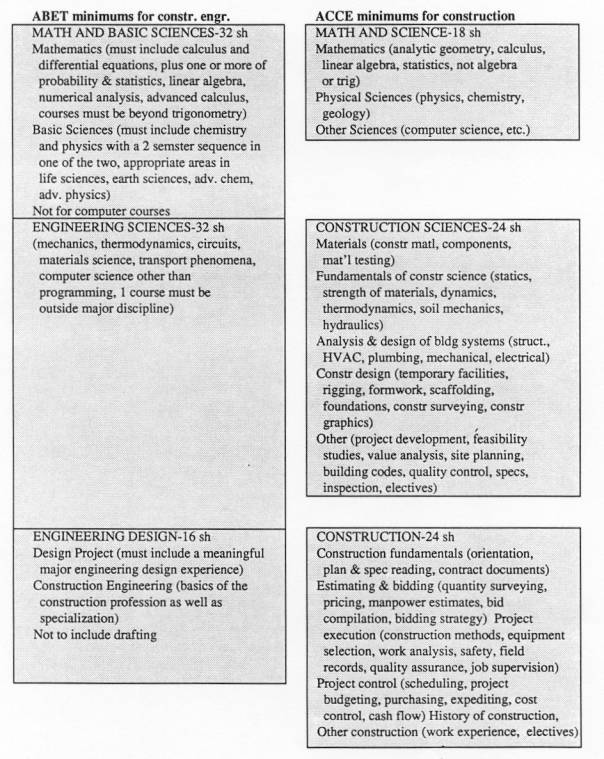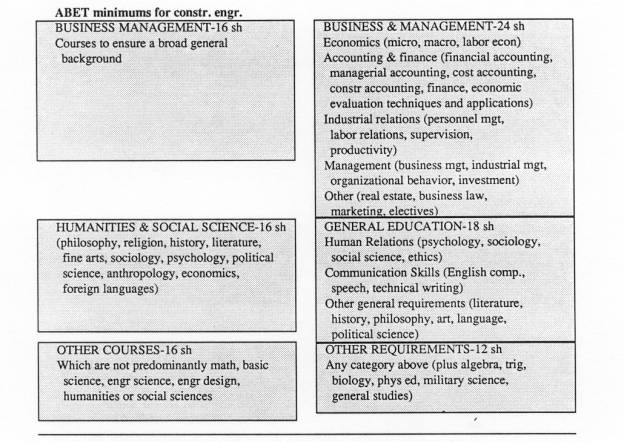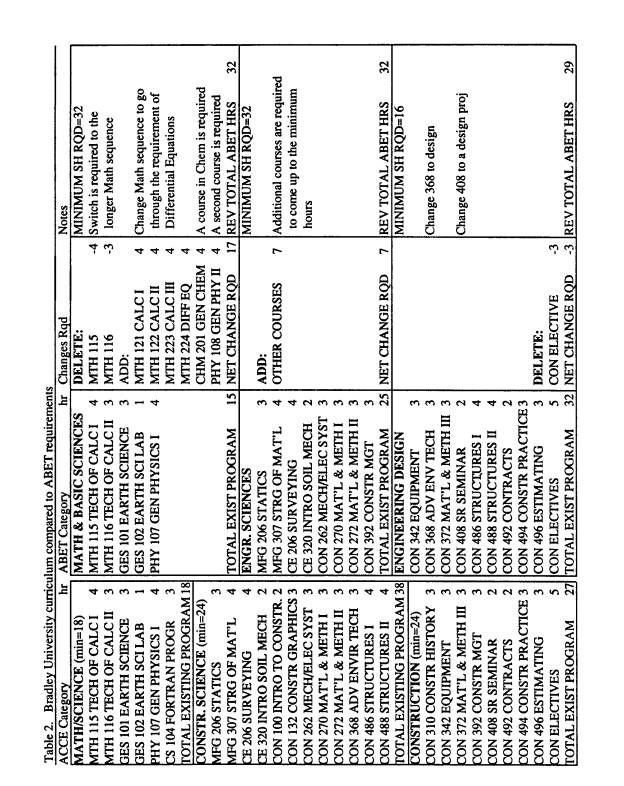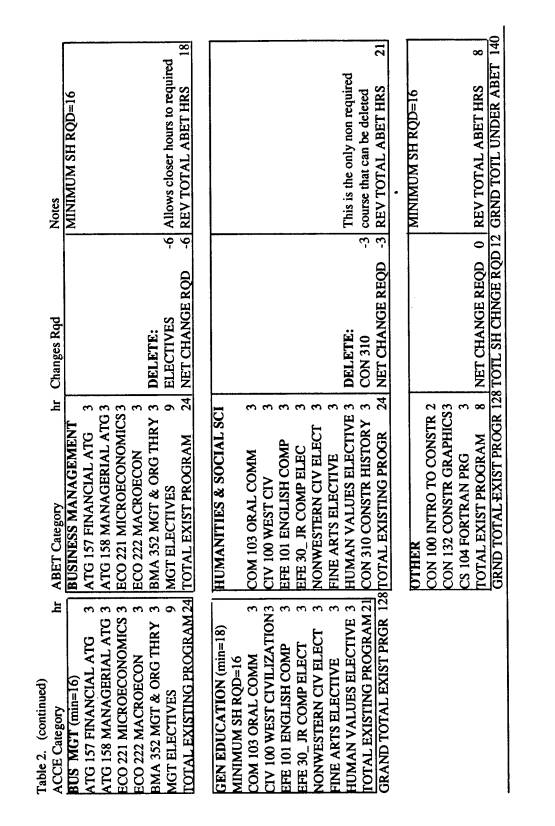(pressing HOME will start a new search)
- ASC Proceedings of the 25th Annual Conference
- University of Nebraska-Lincoln- Lincoln, Nebraska
- April 1989 pp 109-117
|
(pressing HOME will start a new search)
|
|
COMPARISON
OF ACCREDITATION REQUIREMENTS
FOR CONSTRUCTION PROGRAMS
|
F.
Eugene Rebholz and Farzad Shahbodaghlou Bradley
University Peoria,
Illinois |
| Among
the construction programs nationwide, three basic different types exist.
These are: construction engineering, construction management, and
construction technology. Two major accreditation agencies review these
programs. They are ABET (Accreditation Board for Engineering and
Technology), and ACCE (American Council for Construction Education).
ABET reviews construction engineering and also technology programs,
while ACCE reviews the construction management programs. This paper will compare the
curriculum requirements of ABET construction engineering programs with
ACCE construction management programs. The advantages and disadvantages
of each type of accreditation will be discussed. The paper will attempt
to answer the following questions: What courses are in common? Is the
content of certain courses different? What additional courses are needed
in each type of accreditation? What is the philosophy of the courses and
programs? Is it possible to have the curriculum accredited by both
agencies? |
INTRODUCTION
The
authors recently had the opportunity to evaluate the curriculum in construction
at Bradley University with respect to accreditation. The curriculum is currently
accredited by the American Council for Construction Education (ACCE), but
questions were raised within the department about accreditation as an
engineering program by the Accreditation Board for Engineering and Technology
(ABET) or the possibility of being accredited by both agencies. This led to an
investigation of the requirements for accreditation, an evaluation of their
philosophies, advantages or disadvantages, as well as conducting some limited
surveys to gain a feel for the perception of requirements for construction
programs.
The
accrediting agencies have different curriculum requirements because of the
background and philosophy of each agency. ABET (formerly known as ECPD) proposed
accrediting different engineering and engineering technology programs in 1933
and is well established. As would be expected with engineering programs, there
is an emphasis on engineering basics and design.
ACCE
on the other hand, is a newer (1974) accrediting agency that was formed in
response to desires from those in the construction profession for recognition
and quality professional education of graduates unique to their industry. Since
construction is business based, there is an emphasis on business and management
courses that relate to construction.
Accreditation
as construction engineering by ABET or construction management by ACCE are not
the only options. A program could be accredited as an engineering technology
by ABET, though this is often not regarded by engineers as a high professional
level like pure engineering. If a program has its roots in industrial arts, it
may be accredited by NAIT. Finally, a program may find that because of the
limitations that accreditation puts on the curriculum, no accreditation at all
may be a desirable choice.
COMPARISON
OF REQUIREMENTS
ABET
states the background of their curricular requirements in their General
Criteria. "These criteria are intended to assure an adequate foundation in
science, the humanities and the social sciences, engineering sciences and
engineering design methods, as well as preparation in a higher engineering
specialization appropriate to the challenge presented by today's complex and
difficult problems." [1]
The
Curricular Objective and Content section gives more specific information on the
types of courses. "The course-work must include at least:
|
In
addition to the above listed requirements which are common to all engineering
programs, the curriculum for construction engineering is further amplified and
item number (3) is modified to include: "The one-half year in engineering
design should provide a general grounding in the basics of the construction
profession as well as permit some progress towards specialization. A minimum
of one-half year must be allocated to business management courses to ensure a
broad general background." [1]
For
a program requiring 128 semester hours or more, one-half year of study is
considered to be 16 semester hours. For a program requiring fewer total credit
hours, one-half year is considered to be one-eighth of the total program.
On
the other hand, ACCE states in its Standards and Criteria that:
"Construction education should emphasize three areas of student
development:
|
The
curriculum is encouraged to "...provide offerings beyond the required
minimums of the ACCE Standards and Criteria for Accreditation. Curriculum
planning flexibility in the following subject areas recognizes and encourages
differing emphases by the various construction education units. The total
curriculum should support the objectives of the construction education unit
and provide balanced content within the categories." [2]
SIMILARITIES
AND DIFFERENCES
Table
1 on the following pages show both of the accrediting agency curriculum
requirements side by side. The table shows the information both numerically as
well as graphically by the size of the boxes.
Major
Differences
The
major difference in the ABET and ACCE curriculum requirements is the heavy
ABET foundation of courses in the math and basic sciences area, 78% more hours
than the similar courses required by ACCE. The minimum requirement of calculus
through differential equations is something that few other types of construction
programs include. The science requirement is also quite strong in that it
requires both physics and chemistry with a two semester sequence in at least
one of them.
Engineering
sciences is another category where the ABET requirements are higher than ACCE.
Nominally, ABET has 33% more than the ACCE requirement for construction
sciences. However, suggestions for courses that are in the construction sciences
include courses that would not normally fit in the ABET requirement of
engineering sciences. Thus, the number of hours is actually much higher than the
33% that one might think.
Since
engineers are expected to have competence in conducting experimental work,
laboratories are emphasized at the upper level courses with ABET. ABET
requests that even some of the basic sciences include laboratory experience as
well. ABET also looks for demonstration of knowledge and applications of digital
computation techniques to engineering problems.
A
recent requirement of ABET accredited programs is the inclusion of a realistic
engineering design course. Typically, this is interpreted to be a design project
that draws upon previous courses and has factors that act as constraints in the
areas of economics, safety, reliability, aesthetics, ethics, and social impact.
ABET requires only 16 semester hours of business management, while the ACCE
requirement is 50% heavier with 24 semester hours. Another big difference is in
the construction courses themselves. ABET includes the courses for construction
engineering in with engineering design. Since engineering design is likely to
include courses other than construction, the ACCE requirements will undoubtedly
be heavier in construction courses by more than the minimum 50% shown in Table
1.
| Table
1 |
 |
| Table
1 Continued |
 |
Additional
Comparisons
Since
the groups shown in Table 1 do not match course types exactly, care must be
taken in making other than general statements about each. Note that some courses
under one accrediting agency requirements could be modified to fit the other
agency (set up as a design oriented course rather than a survey course e.g.).
This is especially true for engineering sciences vs. construction science,
engineering design vs. construction, and engineering design vs. construction
science.
As
is true for the Bradley curriculum, other universities will have requirements
that add to the hours in some categories so that no one would have only the
minimum number of hours in all categories.
EXAMPLE
CURRICULUM
Table
2 shows how a sample curriculum that is accredited by ACCE fits the categories
for both ABET and ACCE. The Bradley University curriculum is used as an example
in the table, other construction programs would vary slightly. The minimum ACCE
hours are exceeded in some categories because of either the local emphasis and
evolution of courses within the department or the university requirements. For
example, Bradley has a core group of courses that serve as a general education
requirement. This is the reason that the ACCE general education group contains
the courses that are listed and why the hours are greater than the minimum
required.
| Table
2 |
 |
| Table2
continued |
 |
Table
2 further shows the same courses as they would be assigned to the ABET
curriculum groups, as well as some of the changes that would be necessary to
meet the minimum requirements for construction engineering.
Note
that further revisions would be necessary if this curriculum were actually
accredited as an ABET construction engineering program. Further deletions of
courses would be necessary to bring the total number of semester hours (140)
down to a workable number of courses that would fit eight semesters. This would
dictate a change to much of the current philosophy of the curriculum, and
individual courses would have to be redesigned to more correctly match the ABET
category criteria. In the case of the Bradley University program, many of the
courses shown would actually switch to civil engineering existing courses since
the CE program provides many of the service courses for other engineering
courses in the school.
ADVANTAGES/DISADVANTAGES
ABET
Advantages
There are several advantages to having an accredited construction engineering
program.
|
Disadvantages
There are also disadvantages to the ABET programs.
|
ACCE
Advantages
There are some obvious advantages to choosing the ACCE accreditation.
|
Disadvantages
In one sense, the advantages of one type of accreditation are the disadvantages
of the other.
|
Other
considerations
In
deciding whether a program should be accredited by ABET or by ACCE there are a
number of other things that should be examined.
|
TWO
ACCREDITATIONS
It
should be apparent from Table 2 that having one curriculum that is accredited by
both ABET and ACCE is not practical. The curriculum would end up requiring at
least 5 years for students to complete.
However,
having two curricula with separate accreditation for each program would be a
possibility. There aremany common courses that would be included in each of the
programs. In fact, this has been done at North Dakota State University where
within the same department there is an ABET accredited construction engineering
program, an ACCE accredited construction management program, as well as a four
year construction technology program. The obvious dangers are that each
program ends up competing for some of the same students, and resources may be
over extended to cover the courses that are not common to each program.
SURVEY
OF ATTITUDES
Current
seniors majoring in construction at Bradley were surveyed to examine their
feelings about accreditation. Questions were also asked of the industry advisory
committee for the Department of Civil Engineering and Construction.
Students
It
is routine for the department to solicit opinions from the graduating seniors
regarding the curriculum. 22 of the students responded with suggestions on which
courses in the curriculum to emphasize or deemphasize, as well as replying to
questions about the desirability of construction engineering. The results were
inconclusive, but some trends are apparent.
There
were 11 responses indicating that the emphasis should not be changed, with 10
responses suggesting that it be changed to engineering. However, some students
were contradictory by checking both responses, and some did not indicate a
preference. The validity of the responses is questioned even further when it is
noted that the courses that students thought should be deemphasized, typically
included those that would be in the category of engineering sciences. They also
desired even more of an emphasis on the construction management courses. This
obviously contradicts the basics of a construction engineering curriculum. The
conclusion may be that students like the engineering title, but not the
engineering curriculum.
The
majority of the students did like the idea of having the option of becoming
registered as an engineer, and 9 of them indicated that they would at least
consider an employment opportunity in design.
Industry
The
industry advisory committee was also contacted in an effort to get their
opinions. A construction advisory committee had been present for some time, but
with a reorganization in the department administration, graduate civil
engineers were added to the committee.
Again,
the results were inconclusive, with the CE alumni generally favoring
construction engineering and CON alumni favoring construction management.
However, during the advisory committee meeting when discussion was requested on
this topic, one CE graduate was particularly vocal about the necessity of
management courses for engineers, and one CON graduate was a supporter of strong
calculus courses in construction.
CONCLUSION
In
comparing the requirements for ABET and ACCE accreditations, it is most
important to note the different philosophies behind the two programs. ABET was
established to encompass several engineering fields whereas ACCE was
specifically created to address the needs of construction education. ABET
stresses construction engineering, while ACCE focuses on construction
management. The two have different basic requirements and areas of emphasis in
their curriculum. Therefore, it is almost impossible to tailor a four year
program to fit both criteria. However, some schools have solved this problem by
offering both programs but not without creating new concerns. Each program has
its advantages and disadvantages. Nevertheless, in selection of one over the
other, the actual philosophy of the curriculum and the availability of courses
that satisfy the agency's requirements should be examined. This will indicate
the ease of implementing the program. Availability of the resources and local
competition from other schools in the same region should also be considered.
REFERENCES
|